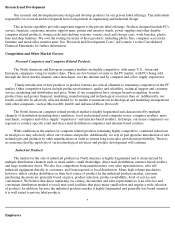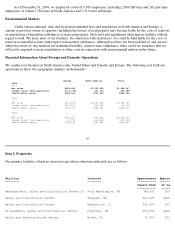Circuit City 2004 Annual Report Download - page 20
Download and view the complete annual report
Please find page 20 of the 2004 Circuit City annual report below. You can navigate through the pages in the report by either clicking on the pages listed below, or by using the keyword search tool below to find specific information within the annual report.
to meet existing strategic and financing objectives. Therefore, liquidity cannot be considered separately from capital
resources that consist of current and potentially available funds for use in achieving long-range business objectives and
meeting debt service commitments. Currently, our liquidity needs arise primarily from working capital requirements
and capital expenditures.
Our working capital was $148 million at December 31, 2004, an increase of $4 million from $144 million at the
end of 2003. This was due principally to a $45 million increase in inventories offset by a $21 million increase in
accounts payable, a $4 million increase in short-term borrowings, a $6 million increase in taxes payable, a $2 million
increase in accrued expense and other current liabilities, a $2 million decrease in cash and a $5 million decrease in
prepaid expenses and other current assets. The $45 million increase in our inventories was comprised of a $40 million
increase in our North American computer products and an $8 million increase in industrial products, which was
partially offset by a decrease in our European inventories in response to weakness in those markets. The increase in
computer products inventories in North America was in response to growing consumer demand for same-day shipping
and the decision to expand the product lines we offer. Our inventories of industrial products increased as we sourced
more of these products from Asia, which practice we expect to continue, and had to compensate for the longer lead
times. As a result of the increased investment in inventories, our inventory turnover declined from 12 to 10 times.
Increases in accounts payable in the United States and in Europe partially offset the working capital impact of the
inventory increase. The increase in our accounts receivable as a percentage was less than the increase in our sales. Our
North American accounts receivable decreased from 17 days of sales outstanding to 13 days, as our sales growth there
came primarily from consumer accounts, which are generally paid by credit card in a 2-3 day shipment-to-cash cycle.
The increase in accounts receivable was attributable to Europe, as the accounts receivable stated in U.S. dollars
increased as a result of changes in exchange rates. We expect that future accounts receivable and inventory balances
will fluctuate with the mix of our net sales between consumer and business customers, as well as geographic regions.
20
We maintain our cash and cash equivalents primarily in money market funds or their equivalent. As of
December 31, 2004, all of our investments mature in less than three months. Accordingly, we do not believe that our
investments have significant exposure to interest rate risk.
Our cash balance decreased $2.4 million to $36.3 million during the year ended December 31, 2004. Net cash
provided by operating activities was $12.8 million for the year ended December 31, 2004, compared with net cash used
in operating activities of $6.6 million in 2003 and net cash provided by operating activities of $4.9 million in 2002. The
$19.4 million increase in cash provided by operating activities in 2004 resulted from an increase in cash provided by
net income adjusted by other non-cash items, such as depreciation expense, and a decrease in cash used for changes in
our working capital accounts. Cash provided by net income and other non-cash items was $27.2 million in 2004, an
increase of $5.5 million, compared to $21.7 million in 2003, and was primarily attributable to the $7.0 million increase
in net income. The cash used for changes in our working capital accounts, which were discussed in the working capital
comments above, was $14.5 million in 2004 compared to $28.3 million in 2003. The decrease of $11.5 million in cash
provided by operations for the year ended December 31, 2003 compared to 2002 resulted from changes in our working
capital accounts, which used $28.3 million in cash compared to using $17.5 million in 2002, and resulted primarily
from a $32 million increase in our inventories. Cash provided from our net income and other non-cash items was $21.7
million in 2003, which was substantially unchanged compared to $22.4 million provided by these items in 2002.
In 2004, $8.3 million of cash was used in investing activities, principally for the purchase of property, plant and
equipment. Capital expenditures in 2004 included upgrades and enhancements to our information and communications
systems hardware and facilities costs for the opening of two additional retail outlet stores in the United States. During
2003, $9.7 million of cash was used in investing activities, principally $7.1 million for the purchase of property, plant
and equipment, and $2.6 million for the acquisition of the minority interest in our Netherlands subsidiary. The capital
expenditures in 2003 included upgrades and enhancements to our information and communications systems hardware
and facilities costs for the opening of several retail outlet stores. Cash of $14.7 million was used in investing activities
in 2002. This included $15.4 million of additions to property, plant and equipment, primarily for the completion of a
new facility for our United Kingdom operations. We anticipate no major capital expenditures in 2005 and will fund any
capital expenditures out of cash from operations and borrowings under our credit lines.
























